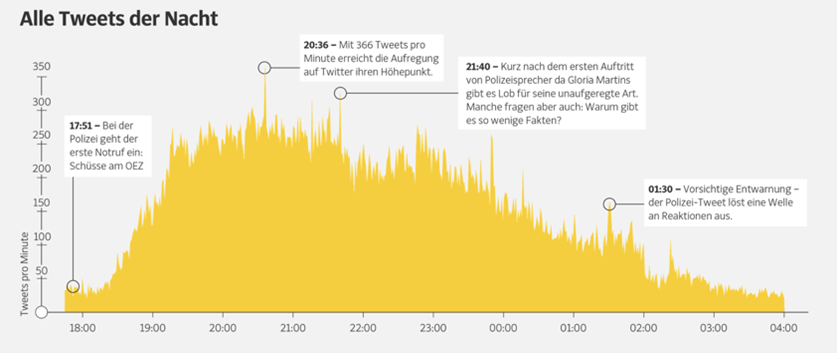From LINKS Community Center
Revision as of 17:40, 25 August 2023 by
Dinu (talk | contribs)
On July 22, 2016, an 18-year-old man shot several people at a fast-food restaurant near the Olympic Shopping Centre in Munich.
2016
Munich, Germany
Crowdsourcing, Social Media
City
After, During
Real-world
Amok, Terror
Two days before the crime, he posted on Facebook inviting other teenagers to come to the fast-food restaurant. Around the afternoon of July 22, the young man visited the restaurant and killed five children and teenagers with a pistol. After that, the perpetrator left the scene and shot at other fleeing people, four of them died. Police tried to shoot the perpetrator to no avail. He hid in an apartment building, left it in the evening and shot himself in front of the police. Initially, the investigators assumed that the rampage was non-political. However, commissioned experts concluded that the crime was right-wing terrorism, as the perpetrator had selected his victims according to racist criteria. Moreover, the day was not chosen by chance, because five years earlier the extreme right-wing attacks in Oslo and Utøya by Anders Breivik took place.
https://www.bpb.de/kurz-knapp/hintergrund-aktuell/336826/vor-5-jahren-rechtsextremer-anschlag-in-muenchen/, https://en.wikipedia.org/wiki/2016 Munich shooting
Collecting and Analysing Information from SMCS, Ensuring Credible Information, Making Information Accessible, Mobilising Volunteers
During the events, rumors are spread on social media, causing panic in the city, several people are injured. The police received 71 reports of alleged gunshots. Via the platform Periscope, users connect live from the crime scene to the Internet. This gives rise to speculation and false reports. The number of tweets on Twitter was increasing enormously.
Good communication with media by the Munich Police's press spokesperson
Twitter, X

Created: 3 March 2023
Last edited: 29 November 2023
On July 22, 2016, an 18-year-old man shot several people at a fast-food restaurant near the Olympic Shopping Centre in Munich.
Hazard:
Amok, Terror
Year:
2016
Location:
Munich, Germany
Scale:
City
Publishing Organisation
unknown
Theme
Crowdsourcing, Social Media
Thematic
- Collecting and Analysing Information from SMCS
- Ensuring Credible Information
- Making Information Accessible
- Mobilising Volunteers
Disaster Management Phase
After, During
Description
Two days before the crime, he posted on Facebook inviting other teenagers to come to the fast-food restaurant. Around the afternoon of July 22, the young man visited the restaurant and killed five children and teenagers with a pistol. After that, the perpetrator left the scene and shot at other fleeing people, four of them died. Police tried to shoot the perpetrator to no avail. He hid in an apartment building, left it in the evening and shot himself in front of the police. Initially, the investigators assumed that the rampage was non-political. However, commissioned experts concluded that the crime was right-wing terrorism, as the perpetrator had selected his victims according to racist criteria. Moreover, the day was not chosen by chance, because five years earlier the extreme right-wing attacks in Oslo and Utøya by Anders Breivik took place.What worked well and could be recommended to others?
Good communication with media by the Munich Police's press spokespersonWhat limitations were identified?
During the events, rumors are spread on social media, causing panic in the city, several people are injured. The police received 71 reports of alleged gunshots. Via the platform Periscope, users connect live from the crime scene to the Internet. This gives rise to speculation and false reports. The number of tweets on Twitter was increasing enormously.Which social media platforms were used?

